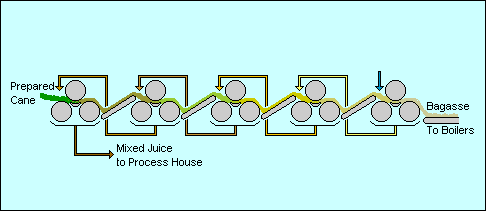How Cane Sugar is Made - Extraction

There are several important aspects to extraction which involve the energy balance of the factory, the efficiency of extraction and therefore ultimately the profitability of operations:
- The manager needs to process the cane as soon as possible if sugar losses are to be avoided yet needs to have a sufficient supply in storage for times when cutting and transport are stopped, whether deliberately or not. Typically, cane is processed within 24 hours of cutting;
- Cane preparation is critical to good sugar extraction, particularly with diffusion extraction. This is achieved with rotating knives and sometimes hammer mills called "shredders". However shredding requires extra energy and more equipment;
- The extraction is actually conducted as a counter-current process using fresh hot water at one end being pumped in the opposite direction to the cane. The more water that is used, the more sugar is extracted but the more dilute the mixed juice is and hence the more energy that is required to evaporate the juice;
- The more accurately that the mills are set [adjusted], the drier is the residual fibre and hence the less sugar remaining in the fibre;
A typical mixed juice from extraction will contain perhaps 15% sugar and the residual fibre, called bagasse, will contain 1 to 2% sugar, about 50% moisture and some of the sand and grit from the field as "ash". A typical cane might contain 12 to 14% fibre which, at 50% moisture content gives about 25 to 30 tons of bagasse per 100 tons of cane or 10 tons of sugar.



|
